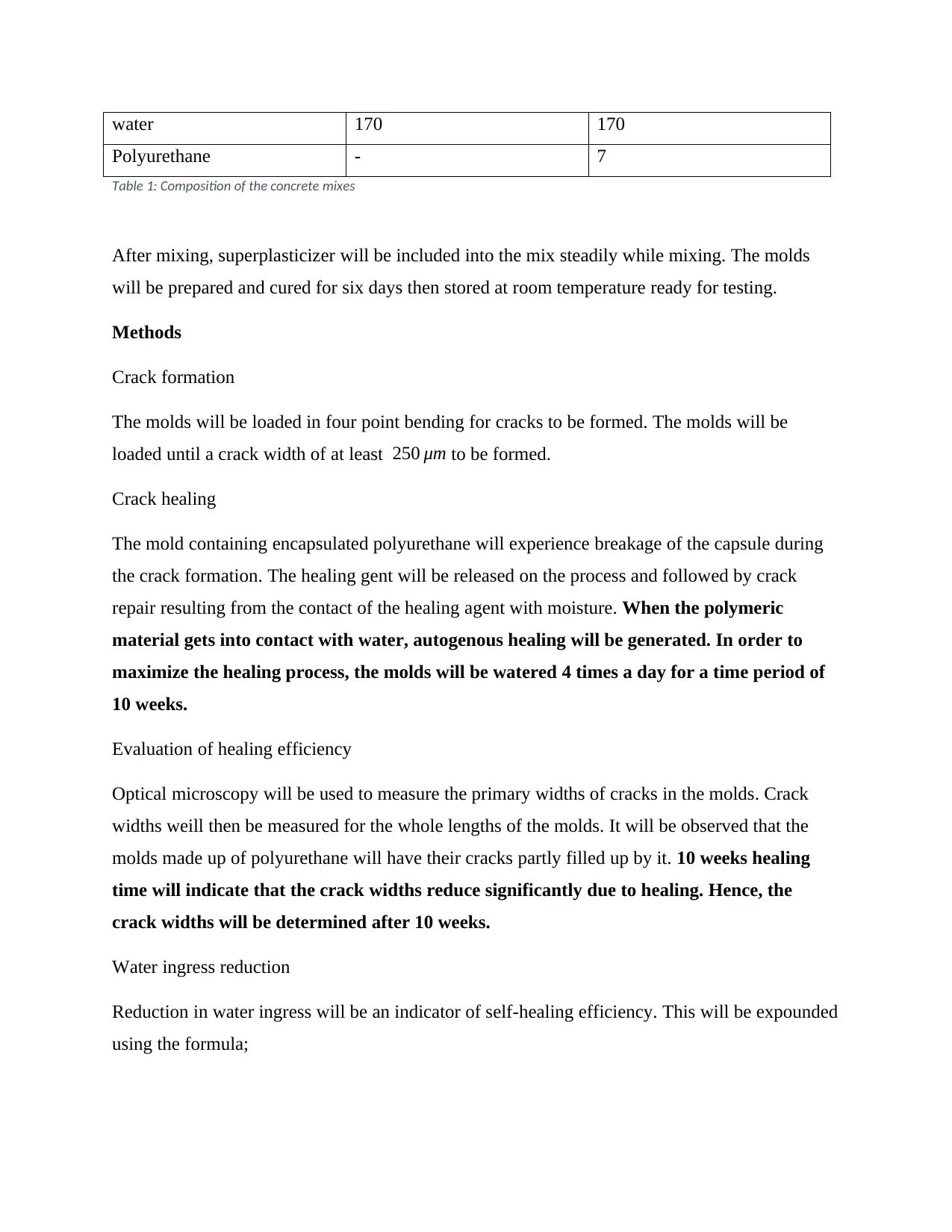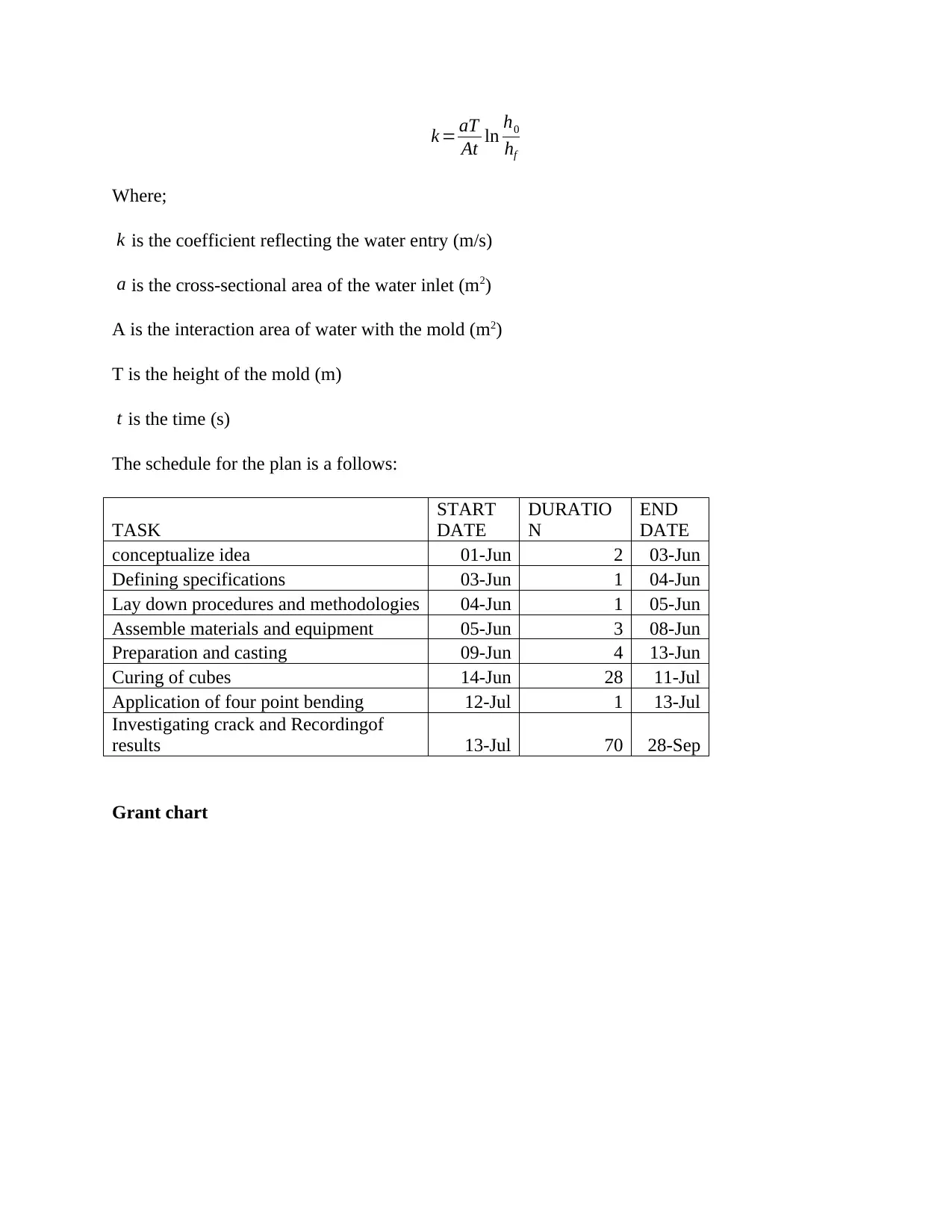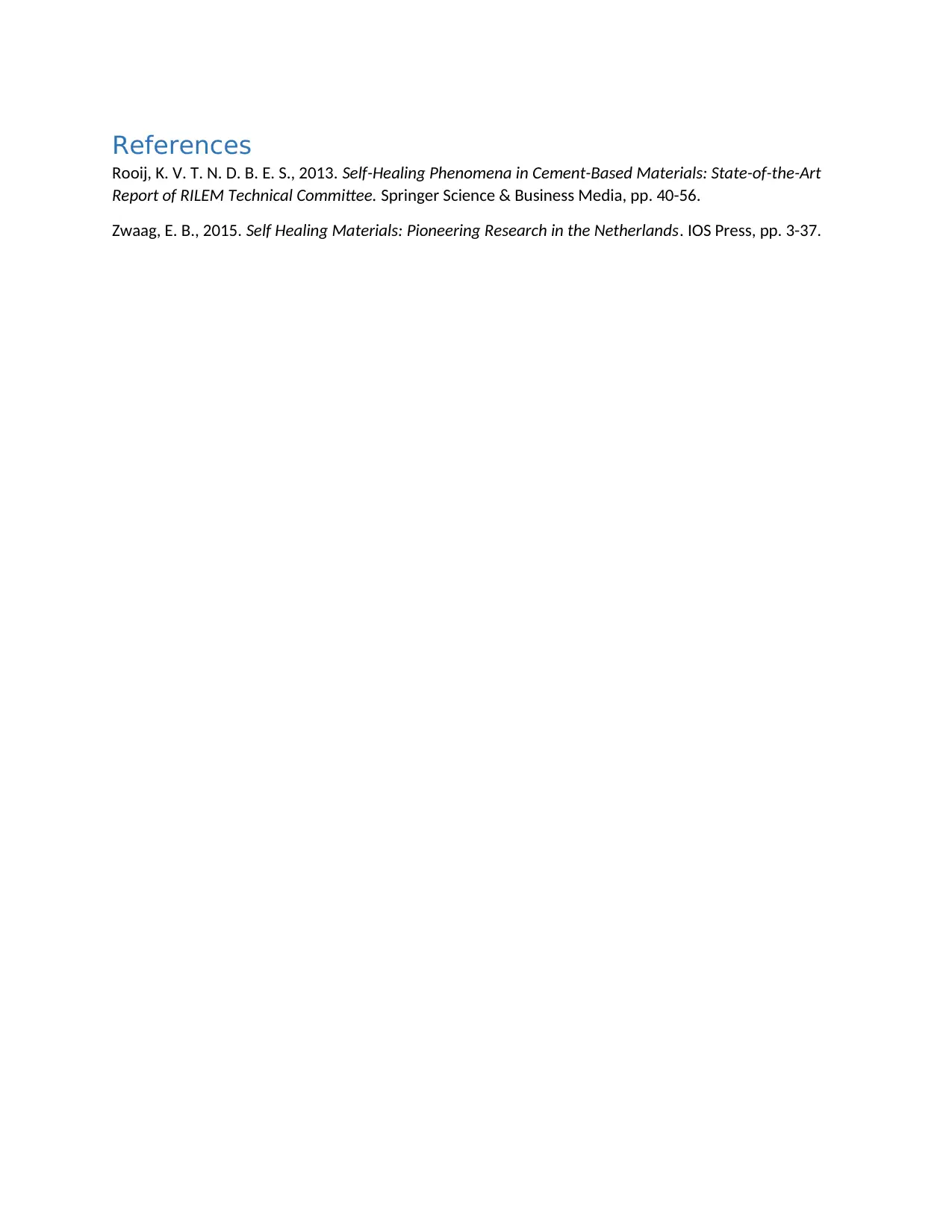Proposal for Measuring Efficiency of Self-Healing Concrete Systems
VerifiedAdded on 2023/04/23
|6
|1146
|183
Report
AI Summary
This report outlines a comprehensive plan to evaluate the self-healing properties of concrete. The study involves testing three concrete samples of varying sizes under four-point bending to induce cracking. The efficiency of autonomous crack repair will be assessed over a 10-week period using crack-mouth opening displacement and digital image correlation. The self-healing mechanism utilizes encapsulated polyurethane, which is released upon cracking to initiate crack repair through moisture interaction. The study includes detailed material compositions, mixing procedures, and a schedule for crack formation, healing, and efficiency evaluation, including water ingress reduction measurements. References to relevant research are also included, offering a thorough approach to understanding and measuring self-healing concrete efficiency.

A plan for proposal on measuring the efficiency of self-healing
concrete using Shape Memory Polymer concrete crack closure
activated by electrical system
ABSTRACT
Three samples of concrete measuring 500 x 100 x 100 mm, 750 x 150 x 150 mm and 650 mm x
150 mm x 150 mm will be tested to determine their self-healing properties. These samples will
be exposed to four-point bending and their efficiencies of autonomous crack repair evaluated
over 10 weeks. To measure the efficiency of crack closure we will use crack-mouth opening
displacement and digital image correlation equipment. We notice that when we increase the size
of the sample the crack closure efficiency decrease due to these reasons.
INTRODUCTION
In construction, concrete is the most preferred material because of its high compressive strength,
ease of molding and low cost. However, concrete is susceptible to cracking due to its low tensile
strength. Reinforcement is usually embedded in it to upturn the tensile strength of the concrete.
Cracking affects the durability of the structure and leads to degradation because of corrosion of
the steel reinforcements. There is need to minimize the cracks developing in concrete to avoid
frequent repairs on the structure.
Cement has self-ability to repair damage to a certain limit. However, this ability is limited and
the need to obtain a polymeric material to fasten the process is under intense research (Rooij,
2013). Water penetrating through the cracks and getting into contact with unhydrated cement
particles additionally hydrate the concrete and leads to closure of the crack. Polymeric material
are utilized to regulate the crack width through absorption of water entering the concrete through
the cracks (Zwaag, 2015).
MATERIALS
Self-healing mechanisms
concrete using Shape Memory Polymer concrete crack closure
activated by electrical system
ABSTRACT
Three samples of concrete measuring 500 x 100 x 100 mm, 750 x 150 x 150 mm and 650 mm x
150 mm x 150 mm will be tested to determine their self-healing properties. These samples will
be exposed to four-point bending and their efficiencies of autonomous crack repair evaluated
over 10 weeks. To measure the efficiency of crack closure we will use crack-mouth opening
displacement and digital image correlation equipment. We notice that when we increase the size
of the sample the crack closure efficiency decrease due to these reasons.
INTRODUCTION
In construction, concrete is the most preferred material because of its high compressive strength,
ease of molding and low cost. However, concrete is susceptible to cracking due to its low tensile
strength. Reinforcement is usually embedded in it to upturn the tensile strength of the concrete.
Cracking affects the durability of the structure and leads to degradation because of corrosion of
the steel reinforcements. There is need to minimize the cracks developing in concrete to avoid
frequent repairs on the structure.
Cement has self-ability to repair damage to a certain limit. However, this ability is limited and
the need to obtain a polymeric material to fasten the process is under intense research (Rooij,
2013). Water penetrating through the cracks and getting into contact with unhydrated cement
particles additionally hydrate the concrete and leads to closure of the crack. Polymeric material
are utilized to regulate the crack width through absorption of water entering the concrete through
the cracks (Zwaag, 2015).
MATERIALS
Self-healing mechanisms
Paraphrase This Document
Need a fresh take? Get an instant paraphrase of this document with our AI Paraphraser

It will involve induction of encapsulated polyurethane into the concrete materials. Air-curing
agent present in polyurethane has a viscosity of 3536 mPas at room temperature. Polyurethane
will remain liquid in nature up to capsule breakage and eventually flow into the cracks in order
to be in contact with moisture. The capsules will then be introduced into workable concrete to
gain the healing properties. When a crack appears in the concrete, the capsule will break to
release the polymeric material into the crack. The polymer will be in contact with the moisture
and a reaction will take place which will lead to hardening of the agent and subsequent repair of
the crack.
Concrete with (out) induced healing mechanism
A base sample concrete will be prepared lacking self-healing properties. Molds of 500 x 100 x
100 mm, 750 x 150 x 150 mm and 1000 x 200 x 200 mm will be utilized for both base and self-
healing samples. The base sample will be prepared as per ACI code requirements with a cover of
20mm and four bars of diameter 10 mm equally placed in the mold across the width.
Concrete with polyurethane will be cast. The capsules will be placed in the mold by use of wires
attached on the walls 15 mm from the top. They will be placed at a distance of 40 mm apart
across the length. The capsules will alternating from one row to another.
The molds will be prepared and the together with the mixes. Compacting the mixes using a
needle will be impossible due to the connected wires and therefore, self-compacting concrete
will be used instead.
Mixing procedure
Materials to be mixed together to form the concrete paste together with their compositions are
shown in table 1.
Composition [kg/m3]
Components Base sample Sample with polyurethane
Sand 0/5 950 950
Cement I 52.5 N 450 450
Gravel 8/16 423 423
Gravel 2/8 375 375
agent present in polyurethane has a viscosity of 3536 mPas at room temperature. Polyurethane
will remain liquid in nature up to capsule breakage and eventually flow into the cracks in order
to be in contact with moisture. The capsules will then be introduced into workable concrete to
gain the healing properties. When a crack appears in the concrete, the capsule will break to
release the polymeric material into the crack. The polymer will be in contact with the moisture
and a reaction will take place which will lead to hardening of the agent and subsequent repair of
the crack.
Concrete with (out) induced healing mechanism
A base sample concrete will be prepared lacking self-healing properties. Molds of 500 x 100 x
100 mm, 750 x 150 x 150 mm and 1000 x 200 x 200 mm will be utilized for both base and self-
healing samples. The base sample will be prepared as per ACI code requirements with a cover of
20mm and four bars of diameter 10 mm equally placed in the mold across the width.
Concrete with polyurethane will be cast. The capsules will be placed in the mold by use of wires
attached on the walls 15 mm from the top. They will be placed at a distance of 40 mm apart
across the length. The capsules will alternating from one row to another.
The molds will be prepared and the together with the mixes. Compacting the mixes using a
needle will be impossible due to the connected wires and therefore, self-compacting concrete
will be used instead.
Mixing procedure
Materials to be mixed together to form the concrete paste together with their compositions are
shown in table 1.
Composition [kg/m3]
Components Base sample Sample with polyurethane
Sand 0/5 950 950
Cement I 52.5 N 450 450
Gravel 8/16 423 423
Gravel 2/8 375 375

water 170 170
Polyurethane - 7
Table 1: Composition of the concrete mixes
After mixing, superplasticizer will be included into the mix steadily while mixing. The molds
will be prepared and cured for six days then stored at room temperature ready for testing.
Methods
Crack formation
The molds will be loaded in four point bending for cracks to be formed. The molds will be
loaded until a crack width of at least 250 μm to be formed.
Crack healing
The mold containing encapsulated polyurethane will experience breakage of the capsule during
the crack formation. The healing gent will be released on the process and followed by crack
repair resulting from the contact of the healing agent with moisture. When the polymeric
material gets into contact with water, autogenous healing will be generated. In order to
maximize the healing process, the molds will be watered 4 times a day for a time period of
10 weeks.
Evaluation of healing efficiency
Optical microscopy will be used to measure the primary widths of cracks in the molds. Crack
widths weill then be measured for the whole lengths of the molds. It will be observed that the
molds made up of polyurethane will have their cracks partly filled up by it. 10 weeks healing
time will indicate that the crack widths reduce significantly due to healing. Hence, the
crack widths will be determined after 10 weeks.
Water ingress reduction
Reduction in water ingress will be an indicator of self-healing efficiency. This will be expounded
using the formula;
Polyurethane - 7
Table 1: Composition of the concrete mixes
After mixing, superplasticizer will be included into the mix steadily while mixing. The molds
will be prepared and cured for six days then stored at room temperature ready for testing.
Methods
Crack formation
The molds will be loaded in four point bending for cracks to be formed. The molds will be
loaded until a crack width of at least 250 μm to be formed.
Crack healing
The mold containing encapsulated polyurethane will experience breakage of the capsule during
the crack formation. The healing gent will be released on the process and followed by crack
repair resulting from the contact of the healing agent with moisture. When the polymeric
material gets into contact with water, autogenous healing will be generated. In order to
maximize the healing process, the molds will be watered 4 times a day for a time period of
10 weeks.
Evaluation of healing efficiency
Optical microscopy will be used to measure the primary widths of cracks in the molds. Crack
widths weill then be measured for the whole lengths of the molds. It will be observed that the
molds made up of polyurethane will have their cracks partly filled up by it. 10 weeks healing
time will indicate that the crack widths reduce significantly due to healing. Hence, the
crack widths will be determined after 10 weeks.
Water ingress reduction
Reduction in water ingress will be an indicator of self-healing efficiency. This will be expounded
using the formula;
⊘ This is a preview!⊘
Do you want full access?
Subscribe today to unlock all pages.

Trusted by 1+ million students worldwide

k = aT
At ln h0
hf
Where;
k is the coefficient reflecting the water entry (m/s)
a is the cross-sectional area of the water inlet (m2)
A is the interaction area of water with the mold (m2)
T is the height of the mold (m)
t is the time (s)
The schedule for the plan is a follows:
TASK
START
DATE
DURATIO
N
END
DATE
conceptualize idea 01-Jun 2 03-Jun
Defining specifications 03-Jun 1 04-Jun
Lay down procedures and methodologies 04-Jun 1 05-Jun
Assemble materials and equipment 05-Jun 3 08-Jun
Preparation and casting 09-Jun 4 13-Jun
Curing of cubes 14-Jun 28 11-Jul
Application of four point bending 12-Jul 1 13-Jul
Investigating crack and Recordingof
results 13-Jul 70 28-Sep
Grant chart
At ln h0
hf
Where;
k is the coefficient reflecting the water entry (m/s)
a is the cross-sectional area of the water inlet (m2)
A is the interaction area of water with the mold (m2)
T is the height of the mold (m)
t is the time (s)
The schedule for the plan is a follows:
TASK
START
DATE
DURATIO
N
END
DATE
conceptualize idea 01-Jun 2 03-Jun
Defining specifications 03-Jun 1 04-Jun
Lay down procedures and methodologies 04-Jun 1 05-Jun
Assemble materials and equipment 05-Jun 3 08-Jun
Preparation and casting 09-Jun 4 13-Jun
Curing of cubes 14-Jun 28 11-Jul
Application of four point bending 12-Jul 1 13-Jul
Investigating crack and Recordingof
results 13-Jul 70 28-Sep
Grant chart
Paraphrase This Document
Need a fresh take? Get an instant paraphrase of this document with our AI Paraphraser

conceptualize idea
Defining specifications
Lay down procedures and methodologies
Assemble materials and equipment
Preparation and casting
Curing of cubes
Application of four point bending
Investigating crack and Recordingof results
1-Jun 21-Jun 11-Jul 31-Jul 20-Aug 9-Sep 29-Sep
Axis Title
Defining specifications
Lay down procedures and methodologies
Assemble materials and equipment
Preparation and casting
Curing of cubes
Application of four point bending
Investigating crack and Recordingof results
1-Jun 21-Jun 11-Jul 31-Jul 20-Aug 9-Sep 29-Sep
Axis Title

References
Rooij, K. V. T. N. D. B. E. S., 2013. Self-Healing Phenomena in Cement-Based Materials: State-of-the-Art
Report of RILEM Technical Committee. Springer Science & Business Media, pp. 40-56.
Zwaag, E. B., 2015. Self Healing Materials: Pioneering Research in the Netherlands. IOS Press, pp. 3-37.
Rooij, K. V. T. N. D. B. E. S., 2013. Self-Healing Phenomena in Cement-Based Materials: State-of-the-Art
Report of RILEM Technical Committee. Springer Science & Business Media, pp. 40-56.
Zwaag, E. B., 2015. Self Healing Materials: Pioneering Research in the Netherlands. IOS Press, pp. 3-37.
⊘ This is a preview!⊘
Do you want full access?
Subscribe today to unlock all pages.

Trusted by 1+ million students worldwide
1 out of 6
Your All-in-One AI-Powered Toolkit for Academic Success.
+13062052269
info@desklib.com
Available 24*7 on WhatsApp / Email
![[object Object]](/_next/static/media/star-bottom.7253800d.svg)
Unlock your academic potential
Copyright © 2020–2025 A2Z Services. All Rights Reserved. Developed and managed by ZUCOL.


